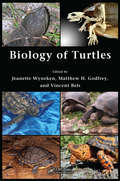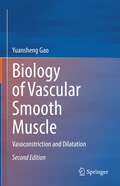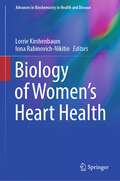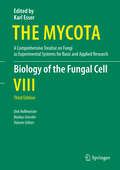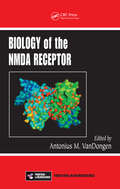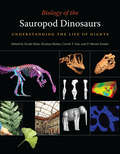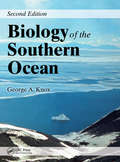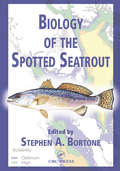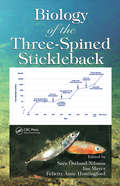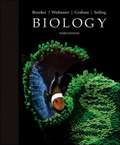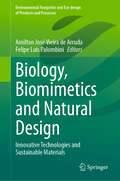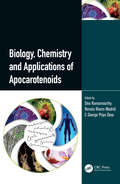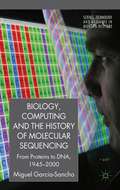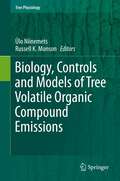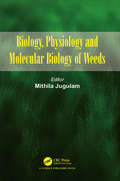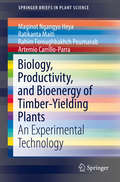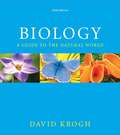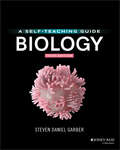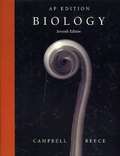- Table View
- List View
Biology of Turtles: From Structures to Strategies of Life
by Vincent Bels Jeanette Wyneken Matthew H. GodfreyFeaturing in-depth contributions from an international team of experts, the Biology of Turtles provides the first comprehensive review of the Testudinata. The book starts with the premise that the structure of turtles is particularly interesting and best understood within the context of their development, novelty, functional diversity, and e
Biology of Vascular Smooth Muscle: Vasoconstriction and Dilatation
by Yuansheng GaoThis book provides a concise yet comprehensive review of the morphological, biochemical, electrical, mechanical, and metabolic properties of vascular smooth muscle, the regulation of vascular activities and the intracellular signaling involved. It particularly focuses on recently identified vasoactive agents, enzymes and transduction mechanisms. It also discusses the latest findings in the regulation of cerebral, coronary and pulmonary circulation as well as vascular activity under hypoxia and ageing. The contraction and dilatation activities of vasculature are of fundamental importance for maintaining circulation homeostasis and adapting physiological changes. Over the last four decades, there have been significant advances in our understanding of the biochemical, structural, genetic, physiological, and pharmacological aspects of vascular activity regulation, and these insights into the responsiveness of blood vessels under normal and pathophysiological conditions help to provide valuable weapons in the fight vascular diseases. The book is of interest to researchers and graduate students, both in basic research and in clinic settings, in the field of vascular biology.
Biology of Vascular Smooth Muscle: Vasoconstriction and Dilatation
by Yuansheng GaoThis book provides a concise yet comprehensive review of the morphological, biochemical, electrical, mechanical, and metabolic properties of vascular smooth muscle, the regulation of vascular activities and the intracellular signaling involved. It particularly focuses on newly identified vasoactive agents, enzymes and transduction mechanisms. It also discusses the latest findings in the regulation of cerebral, coronary and pulmonary circulation as well as vascular activity under hypoxia and ageing. The second edition intends to update the contents of the first edition with the latest achievements in the regulation of vascular activities from biochemical, structural, genetic, physiological, and pharmacological aspects. In addition, two new chapters related to microRNA and extracellular vesicles have been added to reflect their newly discovered important roles in vascular activities. The contraction and dilatation activities of vasculature are of fundamental importance for maintaining circulation homeostasis and adapting to physiological changes. Over the last four decades, there have been significant advances in our understanding of the biochemical, structural, genetic, physiological, and pharmacological aspects of vascular activity regulation, and these insights into the responsiveness of blood vessels under normal and pathophysiological conditions help to provide valuable weapons in the fight vascular diseases. The book is of interest to researchers and graduate students, both in basic research and in clinic settings, in the field of vascular biology.
Biology of Women’s Heart Health (Advances in Biochemistry in Health and Disease #26)
by Lorrie Kirshenbaum Inna Rabinovich-NikitinCardiovascular disease (CVD) is the leading cause of morbidity and mortality in women and men worldwide and represents a major financial burden to world health care systems. Importantly, CVD has eclipsed cancer as the leading cause of death for women globally. Through advancements in research and clinical testing, the symptoms and risk factors for CVD have been well established for men, but not for women. Consequently, there is an immediate need for new innovative research that will bridge this gap and allow for improved early diagnosis and treatment of CVD in women. This book will serve as a guide for health care providers to better understand the physiological, biochemical, and genetic differences in heart disease in women with the goal of providing improved education, awareness and treatment of cardiovascular disease in women. The book will cover topics such as: sex dependent clinical outcomes of cardiovascular disease, cardiac protection by estrogen, cardiac health during menopause, cardiac rehabilitation programs, fitness and exercise, cardio-oncology, shift work and the CVD risk, and pregnancy related CVD.
Biology of the Chemotactic Responses
by J. M. Lackie P. C. WilkinsonThe study of chemotactic reactions has always attracted scientists from many disciplines. Not only does it have an intrinsic fascination as a form of cellular behaviour, but it is now beginning to be possible to approach it at the molecular level. In at least three widely diverse cell types, the enterobacteria, the cellular slime moulds and the mammalian leucocytes, rapid progress is being made in understanding the underlying mechanisms of signal perception and message transduction.
Biology of the Fungal Cell (The Mycota #8)
by Dirk Hoffmeister Markus GresslerThis volume provides a detailed look at various biochemical and developmental aspects of fungal cell biology, and offers extensive information on model organisms of filamentous fungi, such as Aspergillus, and yeasts, such as Saccharomyces, while also highlighting molecular differences between ascomycetes and basidiomycetes. The book’s seven chapters, prepared by experts in the fields of mycology, have been grouped into two closely connected sections: “Fungal Cell Growth” and “Signals and Development”. The first section addresses bio-molecular mechanisms of fungal cell division and polarized cell growth, with a special emphasis on cell-cell connections, cell wall synthesis, and directed protein transport. In turn, the second section describes the intra- and extracellular signals that set off biochemical and conformational changes of cell type during development. Here, the authors focus on the molecular signalling pathways, including their impact on plant-fungus interactions, referred to as ectomycorrhizal symbiosis. Given its scope, the book offers a valuable guide for all microbiologists, geneticists, cell biologists, biochemists and plant biologists, as well as advanced students of biology, who share an interest in the field of mycology.
Biology of the Invertebrates
by Jan PechenikThis textbook is the most concise and readable invertebrates book in terms of detail and pedagogy (other texts do not offer boxed readings, a second color, end of chapter questions, or pronunciation guides). All phyla of invertebrates are covered (comprehensive) with an emphasis on unifying characteristics of each group.
Biology of the NMDA Receptor
by Antonius M. VanDongenThe NMDA receptor plays a critical role in the development of the central nervous system and in adult neuroplasticity, learning, and memory. Therefore, it is not surprising that this receptor has been widely studied. However, despite the importance of rhythms for the sustenance of life, this aspect of NMDAR function remains poorly studied. Written
Biology of the Sauropod Dinosaurs: Understanding the Life of Giants (Life of the Past)
by Nicole Klein, Kristian Remes, Carole T. Gee and P. Martin SanderSauropods, those huge plant-eating dinosaurs, possessed bodies that seem to defy every natural law. What were these creatures like as living animals and how could they reach such uniquely gigantic sizes? A dedicated group of researchers in Germany in disciplines ranging from engineering and materials science to animal nutrition and paleontology went in search of the answers to these questions. Biology of the Sauropod Dinosaurs reports on the latest results from this seemingly disparate group of research fields and integrates them into a coherent theory regarding sauropod gigantism. Covering nutrition, physiology, growth, and skeletal structure and body plans, this volume presents the most up-to-date knowledge about the biology of these enormous dinosaurs.
Biology of the Southern Ocean (CRC Marine Biology Series)
by George A. KnoxFirst published in 1993, The Biology of the Southern Ocean has been referred to as international research at its best and an invaluable reference. Drawing on the considerable volume of information published in the last ten years, this second edition retains the format that made the first edition a popular bestseller, while updating the information
Biology of the Spotted Seatrout (CRC Marine Biology Series)
by Stephen A. BortoneThe spotted seatrout is an important species not only for recreational and commercial fisheries, but also as an integral part of many estuarine ecosystems. As one of the few fishes that live its entire life within an estuarine system, the species has tremendous potential as a monitor or sentinel for estuarine conditions. Prepared by the foremost au
Biology of the Three-Spined Stickleback (CRC Marine Biology Series)
by Sara Östlund-Nilsson Ian Mayer Felicity Anne HuntingfordHighlighting the growing importance of the sticklebacks as a model species in emerging fields such as molecular genetics, genomics, and environmental toxicology, Biology of the Three-Spined Stickleback examines data from researchers who use studies of the stickleback to address a wide range of biological issues. This state-of-the-art volume
Biology, 3rd Edition
by Robert J. Brooker Linda Graham Peter Stiling Eric WidmaierThe first and second editions of BIOLOGY, written by Dr. Rob Brooker, Dr. Eric Widmaier, Dr. Linda Graham, and Dr. Peter Stiling, has reached thousands of students and provided them with an outstanding view of the biological world. Now, the third edition has gotten even better! The author team is dedicated to producing the most engaging and current text that is available for undergraduate students who are majoring in biology. The authors want students to be inspired by the field of biology and become critical thinkers. They understand the goal of a professor is to prepare students for future course work, lab experiences, and careers in the sciences. Building on the successes of the first and second editions, the third edition reflects a focus on core competencies and provides a more learner-centered approach. The strength of an engaging and current text is improved with the addition of new pedagogical features that direct the students' learning goals and provide opportunities for assessment, to determine if students understand the concepts.
Biology, Biomimetics and Natural Design: Innovative Technologies and Sustainable Materials (Environmental Footprints and Eco-design of Products and Processes)
by Felipe Luis Palombini Amilton José Vieira de ArrudaFor billions of years, nature has provided efficient solutions to complex problems, by means of natural selection, in a harsh environment that only the fittest organisms survived. Such sustainable – still ruthless – driven evolution can be explored by designers, architects, engineers and more for the development of innovative projects. Biomimetics makes the link between Biology and Design, where features like shapes, mechanisms, colors, structures, and more can be analyzed, organized, modeled, and simulated for application in multiple creations. Therefore, such knowledge can contribute to more efficient and innovative solutions to many fields of applied science. This project aims to highlight some of the recent technological breakthroughs in Biology, Biomimetics and Natural Design that contribute to the development of sustainable and innovative materials and projects. This work consists of contributions from some of the main international groups of Biomimetics, exhibiting exciting cases of how technological advancements are leading to improved design solutions as well as shaping our very comprehension of nature and its complex organization.
Biology, Chemistry and Applications of Apocarotenoids
by Siva Ramamoorthy Renata Rivera Madrid C George DossCarotenoids are a large class of isoprenoid pigments produced by plants and certain microbes. More than 700 naturally occurring carotenoids have been identified. Apocarotenoids are tailored from carotenoids by oxidative enzymes. Apocarotenoids act as visual or volatile signals to attract pollinating and seed dispersal agents. They are also the key players in allelopathic interactions and plant defense. Biology, Chemistry and Applications of Apocarotenoids provides detailed account of the fundamental chemistry of apocarotenoids and the basic methods used in carotenoid research, and critical discussions of the biochemistry, functions, and applications of these important compounds. Topics covered in the proposed book include various aspects of the roles of apocarotenoids in colour and colouration, photosynthesis and other photofunctions and protection. The formation and roles of carotenoid metabolites and breakdown products as perfume/aroma compounds are also be outlined. Features: Provides an organized overview of apocarotenoids and their chemistry and biological functions Focuses on recent discoveries on apocarotenoids, their nature and functions. Details potential uses of apocarotenoids in agriculture, pharmacy, food industry, and apocarotenoid production at industrial level This book has been written by leading experts in apocarotenoid research and gives a comprehensive overview on the diversity of apocarotenoid compounds and would serve as a reference book for researches in Plant Physiology, Molecular Biology, Biochemistry, Biophysics and Medicine.
Biology, Computing, and the History of Molecular Sequencing: From Proteins to DNA, 1945-2000 (Science, Technology and Medicine in Modern History)
by Miguel García-SanchoSequencing is often associated with the Human Genome Project and celebrated achievements concerning the DNA molecule. However, the history of this practice comprises not only academic biology, but also the world of computer-assisted information management. The book uncovers this history, qualifying the hype and expectations around genomics.
Biology, Controls and Models of Tree Volatile Organic Compound Emissions (Tree Physiology #5)
by Russell K. Monson Ülo NiinemetsPlant-driven volatile organic compound (BVOC) emissions play a major role in atmospheric chemistry, including ozone and photochemical smog formation in the troposphere, and they extend the atmospheric lifetime of the key greenhouse gas, methane. Furthermore, condensation of photo-oxidation products of BVOCs leads to formation of secondary organic aerosols with profound implications for the earth's solar radiation budget and climate. Trees represent the plant life form that most contributes to BVOC emissions, which gives global forests a unique role in regulating atmospheric chemistry. Written by leading experts in the field, the focus is on recent advancements in understanding the controls on plant-driven BVOC emissions, including efforts to quantitatively predict emissions using computer models, particularly on elicitation of emissions under biotic and abiotic stresses, molecular mechanisms of volatile synthesis and emission and the role of emissions in plant stress tolerance.
Biology, Physiology and Molecular Biology of Weeds
by Mithila JugulamThe book provides comprehensive information on a wide range of topics from biology, physiology, genetics to the use of genomic tools in weed science. The book covers information at a more advanced level than the previously published books in weed science. It covers not only weed genetics and genomics research, but also weed management from an ecological perspective. Furthermore, the book also gives a broad coverage of novel mechanisms of weed resistance to herbicides. More importantly, it includes next generation sequencing techniques and bioinformatics of herbicide resistant genes in weeds.
Biology, Productivity and Bioenergy of Timber-Yielding Plants: An Experimental Technology (SpringerBriefs in Plant Science)
by Ratikanta Maiti Maginot Ngangyo Heya Rahim Foroughbakhch Pournavab Artemio Carrillo-ParraFace to the current global energy crisis, there is an urgent necessity of searching for alternatives to fossil fuels, and this book shows how timber is a promising resource for sustainable energy production. Northeast Mexico represents an important forest resource to satisfy the needs of the population in these areas. In order to harness these forest resources, technology for exploring these valuable resources must be developed. These technologies (with special reference to biology and wood technologies) are available in scattered form in a few books but there is no central, comprehensive source for practical forest scientists for adopting efficient forest management, practice, and exploration. This book deals with the characterization of the vegetation, morphology, phenological development, biomass production (leaf, litter, wood), and bioenergy of some timber-yielding species of Northeast Mexico, which will serve as a guide to study timber-yielding plants in the native vegetation of Tamaulipan thornscrub and experimental plantations. This includes morphology, vegetation cover, biomass production in terms of volume leaf biomass, litter, and volume of fire wood and timber. Special emphasis is given to the estimation of bioenergy products and chemical composition (Ph, extractable lignin, and inorganic elements). Large variations exist in vegetation cover, morphology, phenological development, biomass production of leaf and litter, volume of wood and various variable of bioenergy products among the selected species. The maximum production was found in summer and the volume of the harvestable timber was obtained in experimental plantations. This book, therefore, will serve as a practical handbook to characterize timber-yielding plants, which will help to efficiently manage forestry resources.
Biology: A Guide to the Natural World (3rd edition)
by David KroghA book students enjoy reading, this was written and illustrated to guide non-majors through biological concepts and develop their sense of scientific literacy.
Biology: A Guide to the Natural World (5th Edition)
by David KroghDavid Krogh's Biology: A Guide to the Natural World leads readers on a memorable journey through the world of biology, using relevant examples, clearly-developed illustrations, and helpful insights that resonate with today's students. Widely-recognized as a book that students enjoy reading, the Fifth Edition has been thoroughly updated with new discussions on social concerns and health applications, along with streamlined chapter summaries and expanded review questions.
Biology: A Self-Teaching Guide
by Steven D. GarberAn Interactive, Easy-to-Use Introductory Guide to Major Biology Concepts For students looking for a solid introduction to Biology, the new 3rd Edition of Biology: A Teaching Guide is the perfect learning tool. The latest edition has been updated to include the most up-to-date information on everything from photosynthesis to physiology. For students preparing for exams or individuals who want to review material from years past, the step-by-step format is designed to help students and teachers alike easily understand complex concepts, key terms, and frequently asked questions. The guide includes a comprehensive glossary and self-test questions in each chapter, allowing students to reinforce their knowledge and better understand the concepts. In A Teaching Guide, learn about the foundational aspects of biology, including: ● How photosynthesis occurs ● Whether viruses are living or dead ● The reproductive sexual terms behind cloning ● Comprehensive treatment of all aspects of life science Thoroughly updated with self-teaching practice exams and questions, this comprehensive guide is designed to give students the tools they need to master the fundamental concepts and critical definitions behind biology.
Biology: AP (7th Edition)
by Jane B. Reece Neil A. CampbellThis special edition of Campbell/Reece BIOLOGY, Seventh Edition, is designed specifically for the Advanced Placement Biology community of teachers and students. The book's front section includes a few customized items specific to the needs of AP teachers and students.
